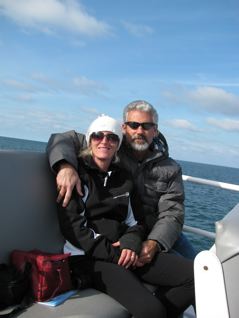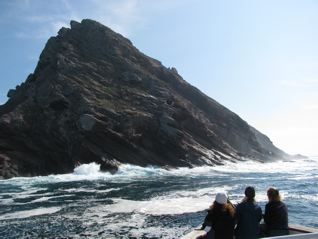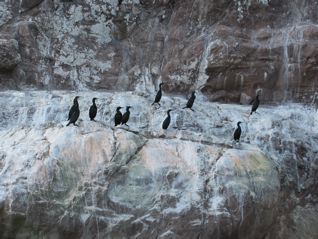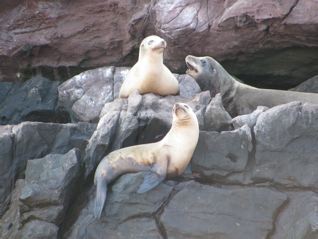
|
|
 |
||||||||||||||||||||
|
|
|||||||||||||||||||||
|
LOS CORONADOS The Coronado Islands Play Host to a Variety of Sea Life Text and Photos by Jon Deinzer We made our way onto the boat on a blustery, cool January morning. Common sense told my girlfriend  and I to dress in layers, and a little coastal knowledge said to bring along a good coat. We did, and were thankful the minute we left the dock. Our San Diego Harbor Excursion had about 15 souls on board, all geeked to see the wildlife we’d heard about that lives just offshore. and I to dress in layers, and a little coastal knowledge said to bring along a good coat. We did, and were thankful the minute we left the dock. Our San Diego Harbor Excursion had about 15 souls on board, all geeked to see the wildlife we’d heard about that lives just offshore. As a transplanted Texan and avid surfer, I’ve lived and surfed in San Diego for over 20 years, and from southern Orange County to well into Mexico, I thought I’d seen just about all there was to see along that stretch of the Pacific shoreline. So when I got the invite to take a nature cruise to the Coronado Islands (aka Islas Los Coronados), I was up for learning about someplace I’d yet to see for myself. Our two captains, Ben and Steve, where as accommodating as they were interesting and amusing. As we left the dock, our lesson from Captain Ben began: via loudspeaker, we learned about the history of the area and in particular San Diego harbor. Motoring west, we passed the Cabrillo Lighthouse and Captain Ben explained it was Juan Cabrillo who first set foot on the West Coast in 1542, and was also the first European on the Coronado Islands: our destination for the day. Entering open water our zippers went north, winter gloves came on, and coffee became the beverage of the morning. Captain Ben kept up a lively explanation regarding our destination. We were actually heading towards four islands  (all of which are in Mexican waters) that provide a home to pelicans, harbor seals, and an array of different sea birds. (all of which are in Mexican waters) that provide a home to pelicans, harbor seals, and an array of different sea birds. My first mate and I were on the lookout for whales and dolphins, and it didn’t take long before the ocean jesters came to entertain. A small pod of Pacific white-sided dolphins showed up, and Captain Ben maneuvered the boat with great skill to keep us in just the right spot to see them dance and loop in and out of the boat’s wake. The Pacific white-sided dolphin is an excellent hunter, he explained, and they’ll work cooperatively amongst themselves to drive schools of fish to the surface. “Bird schools” will then form overhead as seabirds show up for the free lunch, sending the fish schools into a panic; as the fish scatter, the dolphins dine on the chaos they’ve created. We were lucky that day as the ocean was a pristine blue/green, and although there was a 10-foot swell running (sorry, old surfers never die) the boat barely rolled in the gentle seas. Dead Man’s Island was the first island that came into view, and it was a stark contrast  to the languid color of the ocean. The tall, rocky outcroppings were all dark grays and browns that were covered with...well, let’s just call it “seabird icing.” Lots and lots of icing, running in rivulets down the cliff face like shredded cotton. (Seeing as how the island is regarded as “the primary reproductive area for over 3,000 breeding pairs of brown pelicans,” it’s no wonder...) to the languid color of the ocean. The tall, rocky outcroppings were all dark grays and browns that were covered with...well, let’s just call it “seabird icing.” Lots and lots of icing, running in rivulets down the cliff face like shredded cotton. (Seeing as how the island is regarded as “the primary reproductive area for over 3,000 breeding pairs of brown pelicans,” it’s no wonder...)Captain Ben allowed the boat to get as close as safety allowed so we could capture our digital memories by the gigabyte. Dead Man’s Island was featured in some of the Pirates of the Caribbean movies, as well as in the Jurassic Park trilogy. We drifted in and out of a sheltered cove on the rising swell with the ease of a floating booby, getting spellbindingly close to what seemed an eminent Titanic-like crash. But Captain Ben was completely in charge, and we slid away from the island with nary a hair out of place. We drifted past Bird Rock Island and Bomber Rock Island in one/two fashion. Brown pelicans, blue-footed boobies and gulls were swooping into the ocean to pick up what the boat’s propellers had disturbed. As the boat got closer and closer to the islands, nesting pairs screeched their respective warnings and we (like good eco-tourists) merely took photos and pointed. The islands are home to seals; lots and lots of seals. They were everywhere - flopped out on rocky shelves like fat,  rubber sausages roasting on a flat iron. Harbor seals abound, but if you’re lucky you may get a glimpse of massive elephant seals. There are only two places to observe these Goliath's: here on Bomber Island, and at Anos Nuevos up the coast near Santa Cruz. To say these animals are huge is an understatement: the males can reach 5,000 lbs. when fully grown. Nice to have a big boat and lots of water between them and you. rubber sausages roasting on a flat iron. Harbor seals abound, but if you’re lucky you may get a glimpse of massive elephant seals. There are only two places to observe these Goliath's: here on Bomber Island, and at Anos Nuevos up the coast near Santa Cruz. To say these animals are huge is an understatement: the males can reach 5,000 lbs. when fully grown. Nice to have a big boat and lots of water between them and you.We made our way to the final island - South Coronado, which boasted a hotel and casino during the early years of Prohibition when it was frequented by Hollywood movie stars like Mae West and Charlie Chaplin. Today, the island’s occupants are a lot less glamorous yet fascinating nevertheless: we observed oyster divers from Mexico plying their trade from a small panga offshore, while nearby oyster-catchers (a bird that lives only on islands) watched their actions with intense interest. Without wetsuits and using very crude diving equipment, the divers work from dawn until dusk on this lonely island harvesting what’s left of the exhausted oyster population. Not unlike the sardine population in Northern California, it won’t belong before all of the oysters are gone and these fisherman and their way of life will be gone also. It’s hard to think of a sustainable lifestyle when you need all that you can catch in order to survive. Rounding the last island, the boat was turned to port and away we went across the gentle seas heading back to the harbor. But truth be told - although we’d seen a lot of sea life, my first mate was a little disappointed; she’d hoped to see a gray whale on its southern migration to Baja where warm water and plentiful food draws the females to give birth to their calves. As Captain Ben explained, the Arctic waters that the whales normally call home is too cold for the young calves; they need the warmth of Southern Mexico to learn to swim and eat. The calves are 10-15 feet long at birth, and gain 50 lbs. a day after they’re born. At 45 feet long, they weigh a ton-to-a-foot. The babies don’t suckle milk directly from the mother, but drink the 60% fat concoction as the mother swims alongside. They have but a brief time together as they spend one season side-by-side, then go their separate ways. Many whales make this migration, but we were told that if we saw one it could be the size of the boat we were on. When the shout came that we’d sighted a whale, everyone on board bolted for their cameras. In the distance, a telltale spout and whale tail were barely visible above the ocean’s surface. We kept our distance and enjoyed the show for awhile. Oohs and ahhs were the language of the moment, and it was hard not to be impressed with the thought of a creature that big, that calm, with the single-minded purpose of heading south  to continue the circle-of-life. to continue the circle-of-life.As with all adventures ours came to an end. Back at the harbor, we thanked our crew for the safe journey, and gave a turnaround smile to the Coronado Islands and the retreating sun as it disappeared behind a wisp of clouds. FAST FACTS San Diego Harbor Excursion 1050 N. Harbor Drive San Diego, CA 92101 (619) 234-4111; (800) 442-7847 www.sdhe.com |
|
|
|
|
| Site Map |